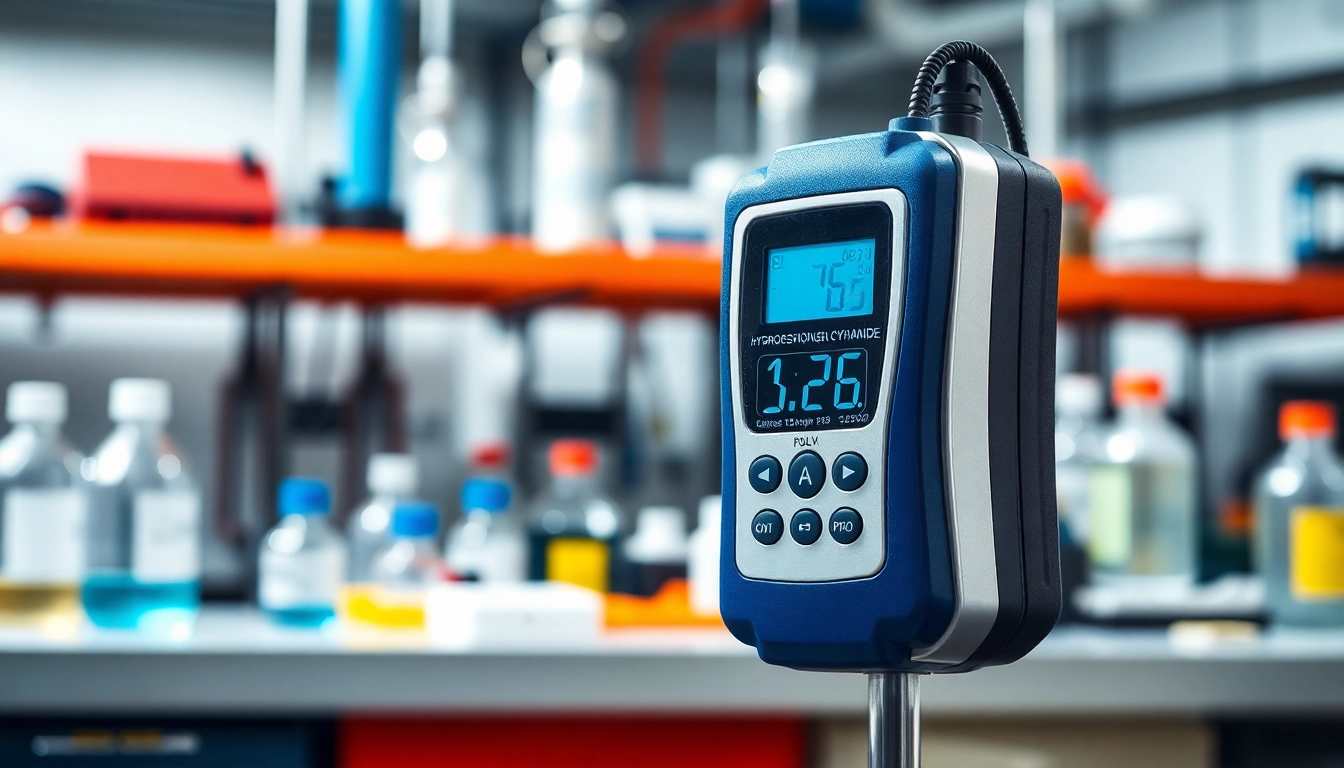
Understanding Hydrogen Cyanide and Its Dangers
What is Hydrogen Cyanide?
Hydrogen Cyanide (HCN) is a highly toxic chemical compound often used in various industrial processes, such as the production of plastics, synthetic fibers, and pesticides. It is known for its colorless gas form at room temperature and has a distinctive bitter almond odor, although not everyone can detect it due to genetic factors. HCN has been historically notorious not only for its industrial applications but also for its potential use as a chemical weapon. Given its high toxicity, even at low concentrations, understanding the properties and risks associated with hydrogen cyanide is crucial for enhancing workplace safety.
Health Risks and Exposure Levels
Exposure to hydrogen cyanide can occur through inhalation, ingestion, or absorption via the skin, leading to various health complications. The effects are immediate and can range from headaches and dizziness to more severe symptoms such as respiratory failure, seizures, and even death. The Occupational Safety and Health Administration (OSHA) establishes permissible exposure limits (PELs) for HCN in industrial settings, generally set at 10 parts per million (ppm) over an 8-hour work shift. However, acutely toxic effects can occur at concentrations as low as 300 ppm, illustrating the critical need for effective monitoring and detection systems in environments where hydrogen cyanide is present.
Regulatory Standards and Compliance
Regulatory compliance is essential in industries dealing with hazardous materials. Agencies like OSHA and the Environmental Protection Agency (EPA) mandate strict reporting and safety protocols for hydrogen cyanide. Employers are required to implement exposure monitoring and maintain records of HCN levels in the workplace. Compliance with these regulations not only protects workers but also shields businesses from potential liabilities and legal consequences. Utilizing a Hydrogen Cyanide detector is a key component in achieving regulatory compliance and ensuring a safe working environment.
Importance of Using a Hydrogen Cyanide Detector
Why Detection is Critical in Industrial Settings
In industrial settings, the importance of immediate and accurate detection of hydrogen cyanide cannot be overstated. Given the rapid onset of symptoms following exposure, reliance solely on employee reporting can lead to catastrophic events. Detection systems provide early warning, allowing for timely intervention to mitigate accidents, protect human life, and ensure regulatory compliance. Regular monitoring with a reliable detector can also help identify leaks or unsafe levels before they become critical hazards, fostering a culture of safety within the workplace.
Common Applications for Hydrogen Cyanide Detectors
Hydrogen Cyanide detectors find applications across various industries, including chemical manufacturing, mining, and agriculture. In the chemical industry, detectors are used during the handling of HCN and related compounds to prevent exposure incidents. Similarly, in mining operations, workers may be exposed to hydrogen cyanide as a byproduct during ore processing. In agriculture, where HCN is present in some pesticides, utilizing detectors ensures safe application and storage practices. The specificity and reliability of these detectors are paramount in ensuring personnel safety and ecological protection in all scenarios.
Choosing the Right Detector for Your Needs
Selecting the right hydrogen cyanide detector involves assessing various factors, including the detector technology, sensitivity levels, and application-specific requirements. Various technologies exist, including electrochemical sensors, infrared sensors, and photoionization detectors. Each technology has its pros and cons, making it essential for professionals to consider the specific environment and potential concentration levels of hydrogen cyanide when making a selection. Conducting thorough research and consulting with safety equipment experts can lead to informed decisions that bolster workplace safety.
Features to Look for in a Hydrogen Cyanide Detector
Types of Detection Technologies
Different detection technologies offer distinct advantages and limitations. Electrochemical sensors are popular for their high sensitivity and specificity to hydrogen cyanide, making them ideal for low-level detection. Infrared sensors, while generally more expensive, provide robust detection capabilities for a range of gases, including HCN. Photoionization detectors (PIDs) are another effective technology, particularly in volatile environments; they can measure low concentrations and respond quickly to gas presence. Understanding these technologies helps stakeholders choose detectors that fit their specific operational needs.
User-Friendly Interfaces and Readability
A hydrogen cyanide detector’s usability can significantly impact its effectiveness in the field. Detectors with intuitive interfaces that display readings clearly allow operators to respond rapidly to potential hazards. Features such as alarm systems that signal when HCN levels exceed established thresholds are critical for ensuring immediate awareness of dangerous situations. Ensuring your detector has a straightforward, user-friendly design contributes to enhanced safety measures and compliance with operational protocols.
Durability and Maintenance Considerations
Given the often harsh environments in which hydrogen cyanide detectors operate, durability is crucial. Equipment must withstand exposure to chemicals, temperature variations, and physical stresses. Therefore, users should seek detectors built with robust materials designed to last under challenging conditions. Moreover, ongoing maintenance is essential to ensure the detector’s longevity and reliability; this includes regular calibration, battery replacements, and sensor servicing according to manufacturers’ specifications. Establishing a routine maintenance schedule can help prevent equipment failure and ensure consistent performance.
Implementing Hydrogen Cyanide Detection Systems
Installation Process and Best Practices
The installation of hydrogen cyanide detection systems should follow industry best practices to maximize their effectiveness. Positions for detector installation should be determined based on risk assessment and the nature of potential hydrogen cyanide sources. Proper placement can significantly enhance detection capabilities and ensure timely alerts. Additionally, adhering to manufacturer guidelines during installation will help maintain the accuracy of readings and extend the device’s longevity. Engaging with safety professionals during the installation process can also provide insights based on real-world considerations of workplace dynamics.
Integrating with Safety Protocols
Integration of hydrogen cyanide detection systems with existing safety protocols is crucial for a cohesive safety strategy. Detectors should align with emergency procedures and response plans to ensure everyone is prepared for potential exposure scenarios. Regular safety drills and simulations involving the detection system can foster familiarity and preparedness among employees. Continuous evaluation and feedback from staff can also inform necessary adjustments to protocols, further enhancing safety measures.
Training Staff for Effective Use
Training is essential to ensure that all personnel understand how to operate hydrogen cyanide detectors effectively and respond to alarms appropriately. Comprehensive training programs should encompass the functionalities of the detectors, safety protocols related to hydrogen cyanide exposure, and steps to take in case of an emergency. Regular refresher courses can strengthen knowledge retention and help employees stay aware of evolving best practices in chemical safety.
Monitoring and Reporting: Maximizing Safety
Setting Up Alerts and Thresholds
An integral part of a hydrogen cyanide detection system is the establishment of alerts and thresholds. Configuring alarms to trigger at predefined HCN concentrations allows for prompt action to mitigate exposure risks. Choosing appropriate thresholds involves adhering to regulatory standards and tailoring them to site-specific risks. Regular reviews of these settings can lead to better management of safety protocols and adapt to any changes in work conditions or processes.
Analyzing Data for Safety Improvements
Data collected from hydrogen cyanide detectors offers valuable insights into workplace safety. Analyzing usage data and incident reports can help identify patterns or recurrent issues—facilitating informed decisions around safety measures or equipment modifications. Companies should aim to create a culture of utilizing this data for continuous improvement in their safety approaches, thus proactively addressing potential hazards.
Case Studies: Successful Implementations
Successful implementations of hydrogen cyanide detectors illustrate the critical impact they can have on workplace safety. For instance, a chemical manufacturing facility noted a 40% reduction in exposure incidents after integrating a comprehensive detection system alongside enhanced training protocols. Another case involved an agricultural operation that utilized detectors to monitor HCN levels in a pesticide facility, resulting in improved compliance with governmental safety regulations and increased staff confidence in handling potentially hazardous materials. These examples underscore the effectiveness of robust hydrogen cyanide detection systems in fostering safer working environments.






